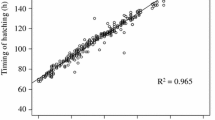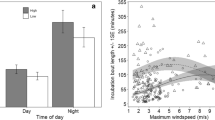Abstract
Hatching asynchrony is widespread amongst animals, but no consensus has yet emerged as to why asynchronous hatching has evolved. It is generally thought to have adaptive benefits during the raising of dependent young. However, here, we considered an alternative view of hatching asynchrony in birds as a consequence of factors acting at the onset of incubation. We recorded parental nest attendance behaviour during laying using continuous records of nest temperature in herring gulls, Larus argentatus. We tested whether nest attendance during laying was related to individual factors (clutch size and diet) and whether it had consequences on fitness outcomes (hatching spread, incubation period, hatching success and chick survival). Low nest attendance was associated with small clutch size, and independent of clutch size, pairs on a more marine diet had lower nest attendance than pairs on a lower trophic level terrestrial diet, possibly due to higher foraging effort for marine food. Broods hatched more asynchronous where pairs had a lower nest attendance during laying or took longer to complete a clutch and where the last egg took longer to hatch. Low nest attendance was also related to shorter incubation periods, possibly representing a strategy of birds in poor condition to reduce the demand of incubation by reducing the length of incubation. We found that low nest attendance during laying and increasing hatching asynchrony had detrimental effects on hatching success for small eggs laid early in the laying sequence. Increasing hatching asynchrony also had a detrimental effect on the survival of the youngest sibling. In our study population, hatching asynchrony was influenced by a more complex set of factors than simply onset of incubation and appears to be constrained by circumstances at the onset of incubation rather than to be an adaptive strategy. Thus, factors acting both during offspring rearing and at the onset of incubation need to be considered for a better understanding of hatching asynchrony.




Similar content being viewed by others
References
Ardia DR, Cooper CB, Dhondt AA (2006) Warm temperatures lead to early onset of incubation, shorter incubation periods and greater hatching asynchrony in tree swallows Tachycineta bicolor at the extremes of their range. J Avian Biol 37:137–142
Arnold TW, Rohwer FC, Armstrong T (1987) Egg viability, nest predation, and the adaptive significance of clutch size in prairie ducks. Am Nat 130:643–653
Beissinger SR, Waltman JR (1991) Extraordinary clutch size and hatching asynchrony of a neotropical parrot. Auk 108:863–871
Board RG, Ayres JC (1965) Influence of temperature on bacterial infection of hens egg. Appl Microbiol 13:358–364
Bogdanova MI, Nager RG (2008) Sex-specific costs of hatching last: an experimental study on herring gulls (Larus argentatus). Behav Ecol Sociobiol 62:1533–1542
Bolton M, Monaghan P, Houston DC (1993) Proximate determination of clutch size in lesser black-backed gulls—the roles of food supply and body condition. Can J Zool 71:273–279
Bortolotti GR, Wiebe KL (1993) Incubation behavior and hatching patterns in the American kestrel Falco sparverius. Ornis Scand 24:41–47
Bradbury RB, Griffiths R (1999) Sex-biased nestling mortality is influenced by hatching asynchrony in the lesser-black-backed gull Larus fuscus. J Avian Biol 30:316–322
Brouwer A, Spaans AL (1994) Egg predation in the herring gull Larus argentatus—why does it vary so much between nests. Ardea 82:223–231
Clark AB, Wilson DS (1981) Avian breeding adaptations—hatching asynchrony, brood reduction, and nest failure. Q Rev Biol 56:253–277
Cook MI, Beissinger SR, Toranzos GA, Rodriguez RA, Arendt WJ (2003) Trans-shell infection by pathogenic micro-organisms reduces the shelf life of non-incubated bird’s eggs: a constraint on the onset of incubation? Proc R Soc Lond B 270:2233–2240
Cook MI, Beissinger SR, Toranzos GA, Arendt W (2005) Incubation reduces microbial growth on eggshells and the opportunity for trans-shell infection. Ecol Lett 8:532–537
DeNiro MJ, Epstein S (1980) Influence of diet on the distribution of nitrogen isotopes in animals. Geochim Cosmochim Acta 45:341–351
Drent RH (1970) Functional aspects of incubation in the Herring gull. Behaviour 17:1–132
Eikenaar C, Berg ML, Komdeur J (2003) Experimental evidence for the influence of food availability on incubation attendance and hatching asynchrony in the Australian reed warbler Acrocephalus australis. J Avian Biol 34:419–427
Flint PL, Grand JB (1999) Incubation behavior of spectacled eiders on the Yukon-Kuskokwim Delta, Alaska. Condor 101:413–416
Gilmore RG (1993) Reproductive biology of lamnoid sharks. Environ Biol Fishes 38:95–114
Hanssen SA, Engebretsen H, Erikstad KE (2002) Incubation start and egg size in relation to body reserves in the common eider. Behav Ecol Sociobiol 52:282–288
Harris MP (1964) Aspects of the breeding biology of the gulls Larus argentatus, L. fuscucs and L. marinus. Ibis 106:432–454
Hébert PN (2002) Ecological factors affecting initiation of incubation behaviour. In: Deeming DC (ed) Avian incubation: behaviour, environment and evolution. Oxford University Press, Oxford, pp 270–279
Hébert PN, McNeil R (1999) Hatching asynchrony and food stress in ring-billed gulls: an experimental study. Can J Zool 77:515–523
Hillström L, Kilpi M, Lindström K (2000) Is asynchronous hatching adaptive in herring gulls (Larus argentatus)? Behav Ecol Sociobiol 47:304–311
Kendra PE, Roth RR, Tallamy DW (1988) Conspecific brood parasitism in the house sparrow. Wilson Bull 100:80–90
Kim M (2008) Eggs, incubation and hatching asynchrony in gulls. PhD thesis, University of Glasgow, Glasgow
Klaassen M, Baarspul T, Dekkers T, van Tienen P (2004) The relationship between carbon stable isotope ratios of hatchling down and egg yolk in black-headed gulls. J Field Ornith 75:196–199
Magrath RD (1990) Hatching asynchrony in altricial birds. Biol Rev 65:587–622
Magrath RD (1992) Roles of egg mass and incubation pattern in establishment of hatching hierarchies in the blackbird (Turdus merula). Auk 109:474–487
Manlove CA, Hepp GR (2000) Patterns of nest attendance in female wood ducks. Condor 102:286–291
Menon GK, Menon J (2000) Avian epidermal lipids: functional considerations and relationship to feathering. Am Zool 40:540–552
Michener R, Lajtha K (2007) Stable isotopes in ecology and environmental science. Blackwell, Oxford
Mock DW, Parker G (1997) The evolution of sibling rivalry. Oxford University Press, New York
Muck C, Nager RG (2006) The effect of laying and hatching order on the timing and asynchrony of hatching. Anim Behav 71:885–892
Nicolai CA, Sedinger JS, Wege ML (2004) Regulation of development time and hatch synchronization in black brant (Branta bernicla nigricans). Funct Ecol 18:475–482
Niebuhr V (1981) An investigation of courtship feeding in herring gulls Larus argentatus. Ibis 123:218–223
Nilsson JA (1993) Energetic constraints on hatching asynchrony. Am Nat 141:158–166
Parsons J (1970) Relationship between egg size and post-hatching chick mortality in herring gull (Larus argentatus). Nature 228:1221
Parsons J (1972) Egg size, laying date and incubation period in herring gull. Ibis 114:536–541
Pierotti R, Annett CA (1990) Diet and reproductive output in seabirds—food choices by individual, free-living animals can affect survival of offspring. Bioscience 40:568–574
Rauter C, Reyer HU (1997) Incubation pattern and foraging effort in the female water pipit Anthus spinoletta. Ibis 139:441–446
Reid JM, Monaghan P, Nager RG (2002) Incubation and the costs of reproduction. In: Deeming DC (ed) Avian incubation. Oxford University Press, Oxford, pp 314–325
Ricklefs RE (1993) Sibling competition, hatching asynchrony, incubation period and life span in altricial birds. Curr Ornithol 11:188–276
Romano M, Caprioli M, Ambrosini R, Rubolini D, Fasola M, Saino N (2008) Maternal allocation strategies and differential effects of yolk carotenoids on the phenotype and viability of yellow legged gull (Larus michahellis) chicks in relation to sex and laying order. J Evol Biol 21:1626–1640
Royle NJ, Hamer KC (1998) Hatching asynchrony and sibling hierarchies in gulls: effects of parental investment decisions, brood reduction and reproductive success. J Avian Biol 29:266–272
Ryan TJ, Plague GR (2004) Hatching asynchrony, survival and fitness of alternative adult morphs in Ambystoma talpoidedeum. Oecologia 140:46–51
Schreiber EA, Burger J (2001) Biology of marine birds. CRC, Boca Raton
Shawkey MD, Mills KL, Dale C, Hill GE (2005) Microbial diversity of wild bird feathers revealed through culture-based and culture-independent techniques. Microb Ecol 50:40–47
Slagsvold T (1986) Hatching asynchrony: interspecific comparison of altricial birds. Am Nat 128:120–125
Slagsvold T, Wiebe KL (2007) Hatching asynchrony and early nesting mortality: the feeding constraint hypothesis. Anim Behav 73:691–700
Smiseth PT, Morgan K (2009) Asynchronous hatching in burying beetles: a test of the peak load reduction hypothesis. Anim Behav 77:519–524
Smiseth PT, Ward RJS, Moore AJ (2006) Asynchronous hatching in Nicrophorus vespilloides, an insect in which parents provide food for their offspring. Funct Ecol 20:151–156
Smith K (1988) Clutch-size dependent asynchronous hatching and brood reduction in Junco hyemalis. Auk 105:200–203
Snow DW, Perrins CM (1998) The birds of the western Palaearctic. Oxford University Press, Oxford
Sockman KW, Schwabl H, Sharp PJ (2000) The role of prolactin in the regulation of clutch size and onset of incubation behavior in the American kestrel. Horm Behav 38:168–176
Stenning MJ (1996) Hatching asynchrony, brood reduction and other rapidly reproducing hypotheses. Tr Ecol Evol 11:243–246
Stoleson SH, Beissinger SR (1995) Hatching asynchrony and the onset of incubation in birds, revisited: when is the critical period? Curr Ornithol 12:191–270
Sydeman WJ, Emslie SD (1992) Effects of parental age, hatching asynchrony, egg size, and the third-chick disadvantage in western gulls. Auk 109:242–248
Tinbergen JM, Williams JB (2002) Energetics of incubation. In: Deeming DC (ed) Avian incubation: behaviour, environment and evolution. Oxford University Press, Oxford, pp 299–313
Veiga JP (1992) Hatching asynchrony in the house sparrow—a test of the egg-viability hypothesis. Am Nat 139:669–675
Vleck CM, Vleck D (1987) Metabolism and energetics of avian embryos. J Exp Zool 1:111–125
Votier SC, Bearhop S, Ratcliffe N, Furness RW (2004) Reproductive consequences for great skuas specializing as seabird predators. Condor 106:275–287
Wang JM, Beissinger SR (2009) Variation in the onset of incubation and its influence on avian hatching success and asynchrony. Anim Behav 78:601–613
While GM, Jones SM, Wapstra E (2007) Birthing asynchrony is not a consequence of asynchronous offspring development in a non-avian vertebrate, the Australian skink Egernia whitii. Funct Ecol 21:513–519
Wiebe KL, Bortolotti GR (1994) Food supply and hatching spans of birds—energy constraints or facultative manipulation. Ecology 75:813–823
Wiebe KL, Wiehn J, Korpimaki E (1998) The onset of incubation in birds: can females control hatching patterns? Anim Behav 55:1043–1052
Acknowledgments
We are grateful to Sim Lee Kheng for help in the field, Scottish Natural Heritage for research permit and J. Lindström for help with drawing Fig. 3. We thank the Scottish Universities Environmental Research Centre (NERC grant EK98-12/06), East Kilbride and, in particular, Dr Rona McGill for carrying out analyses of stable isotopes of carbon and nitrogen. Comments from two anonymous reviewers greatly improved the presentation of this manuscript.
Author information
Authors and Affiliations
Corresponding author
Additional information
Communicated by J. Graves
Rights and permissions
About this article
Cite this article
Kim, M., Furness, R.W. & Nager, R.G. Hatching asynchrony is constrained by parental nest attendance during laying. Behav Ecol Sociobiol 64, 1087–1097 (2010). https://doi.org/10.1007/s00265-010-0923-2
Received:
Revised:
Accepted:
Published:
Issue Date:
DOI: https://doi.org/10.1007/s00265-010-0923-2




